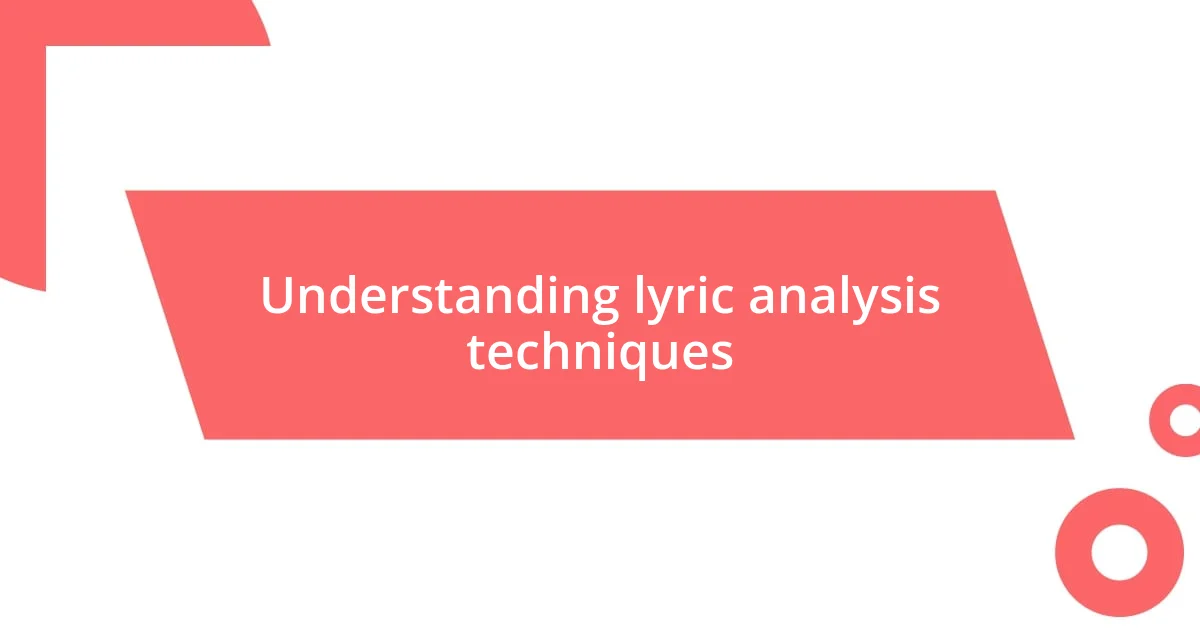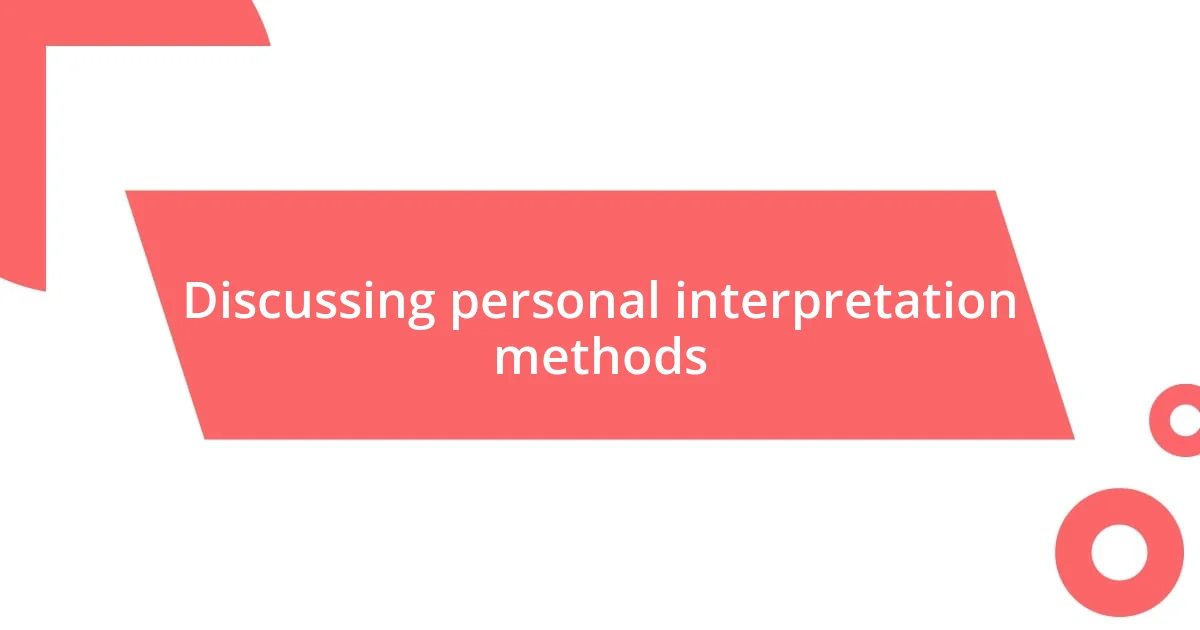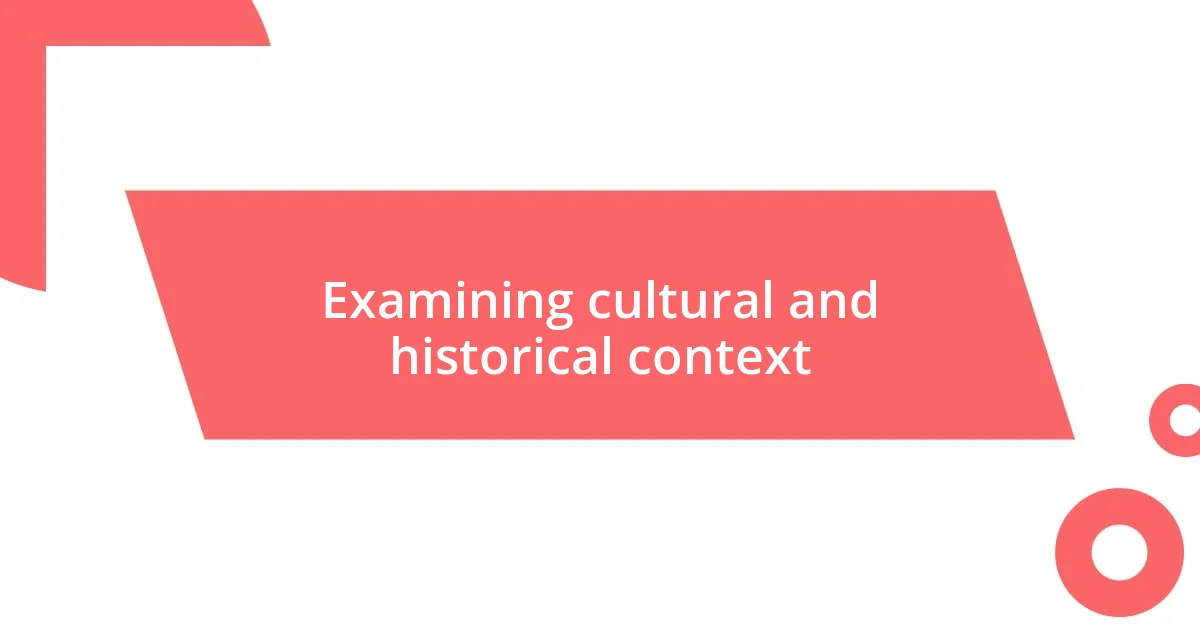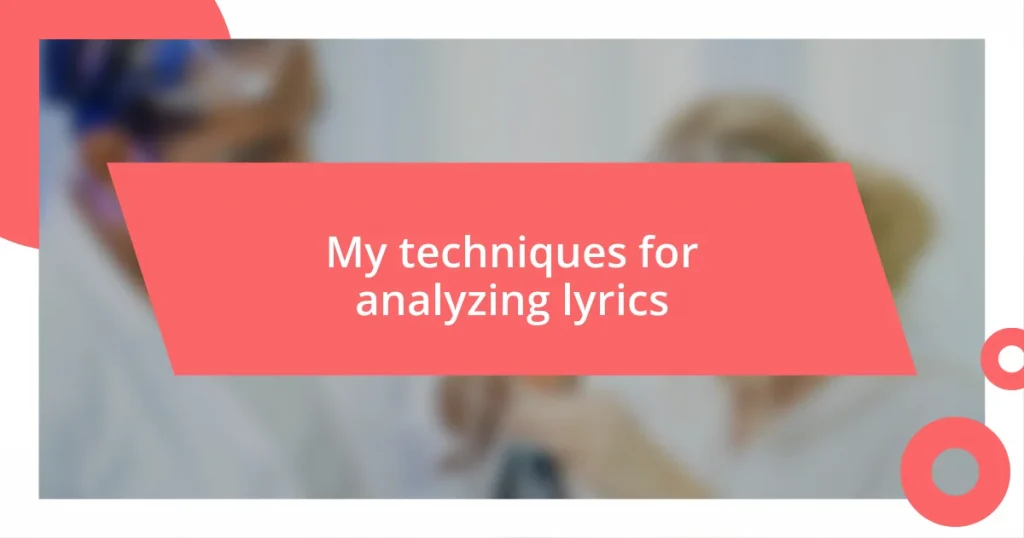Key takeaways:
- Lyric analysis involves breaking down themes, motifs, and personal experiences, enhancing understanding of the emotional depth of songs.
- Literary devices such as alliteration, symbolism, and rhyme schemes significantly enrich lyrics, shaping emotional impact and memorability.
- Context, including cultural, historical, and personal backgrounds, is crucial for interpreting songs and uncovering deeper meanings.

Understanding lyric analysis techniques
When diving into lyric analysis, I often find it valuable to break down the song into its core themes and motifs. For instance, in a song that talks about heartbreak, I pay attention to repeated phrases and imagery that evoke specific emotions. Isn’t it fascinating how a single line can carry so much weight, resonating with personal experiences we’ve all had?
Another technique I use involves considering the artist’s background and how their life experiences shape their music. I remember listening to a track from an artist who grew up in a challenging environment; understanding that context added layers to the lyrics that I hadn’t recognized before. Have you ever thought about how an artist’s struggles influence the depth of their messages?
Additionally, I love looking at the poetic devices within the lyrics, such as metaphors and similes, that enhance the storytelling. While analyzing a recent song, I was struck by a powerful metaphor comparing love to a battlefield. It made me reflect on how relationships can often feel like that; isn’t it intriguing how such comparisons can help us comprehend complex emotions?

Identifying themes and meanings
Identifying themes and meanings in lyrics requires a keen ear and an open mind. Sometimes, I find it helpful to list the recurring phrases or symbols within a song. For example, while dissecting a ballad about loss, I noticed the consistent use of “shadows” and “silence,” which underscored the depth of the singer’s grief. This kind of focused attention leads to rich interpretations that resonate on a personal level.
- Look for repeated phrases and words.
- Pay attention to imagery, like colors or weather.
- Consider the overall mood and tone of the song.
- Reflect on personal experiences that the lyrics evoke.
- Think about cultural or societal influences that might shape the lyrics.
When I first listened to a powerful track about resilience, I couldn’t help but feel moved by the artist’s blend of vulnerability and strength. I even found myself jotting down lines that reminded me of my own challenges. This connection often unveils meanings I hadn’t initially considered, reinforcing the idea that lyrics are not just words but windows into our shared human experience.

Exploring literary devices in lyrics
When I delve into song lyrics, I find that literary devices play a crucial role in enriching the meaning. For example, alliteration can create a rhythmic flow that makes a phrase stick in our minds. I recall a song where the repeated “s” sounds added a serpentine quality to the lyrics, reflecting themes of deception and allure—don’t you think a clever sound can enhance the emotional impact of the words?
Another interesting device is symbolism. A song might use the image of a “broken clock” to symbolize lost time or missed opportunities. I once encountered a line that mentioned “falling leaves” during a breakup. It resonated with me, symbolizing not just the end of a relationship but also the natural cycle of life. Isn’t it intriguing how symbols can convey layers of meaning that connect to our personal experiences?
Moreover, the use of rhyme schemes can also create a sense of cohesion and memorability in lyrics. I remember a catchy tune where the consistent rhyme made the chorus unforgettable. Even now, I find myself humming it at random moments, which speaks volumes about how powerful wordplay can be in drawing us into the song’s narrative. Have you ever caught yourself replaying a song just because the words are so cleverly crafted?
| Literary Device | Description |
|---|---|
| Alliteration | Repetition of consonant sounds for rhythm and emphasis. |
| Symbolism | Use of symbols to represent ideas or concepts beyond the literal meaning. |
| Rhyme Schemes | Pattern of sounds at the end of lines that enhances memorability. |

Analyzing rhyme and rhythm
When I analyze rhyme and rhythm in song lyrics, I’m often struck by how they weave the entire piece together. For instance, I remember listening to a catchy pop song where the alternating rhyme patterns created a lively bounce, almost compelling me to dance. I find this rhythmic element not only makes the lyrics more engaging but often reflects the song’s mood—don’t you feel that beat in your bones?
The rhythm can also play with how we experience the words. In one folk song that deeply resonated with me, the gentle, consistent beat of the verses seemed to mirror the singer’s calm acceptance of life’s unpredictability. When lyrics flow smoothly, it feels like we’re walking hand-in-hand with the artist through their story. Have you ever felt like a song’s rhythm was guiding your emotions, almost as if it understood you?
I often take note of how different rhyme schemes can evoke various feelings. A song filled with couplets can feel tight and cohesive, whereas a more complex scheme evokes curiosity and suspense. I distinctly recall a hip-hop track with intricate internal rhymes that made each line pop with energy. It left me on the edge of my seat, eagerly anticipating what would come next. Do you notice how certain rhythms and rhymes can completely transform your listening experience?

Discussing personal interpretation methods
When it comes to personal interpretation, I find that context plays a pivotal role. I often reflect on the artist’s background and experiences to gain insights into their lyrics. For instance, understanding a singer’s struggles can provide depth to songs about heartbreak or resilience. Have you ever felt that knowing a bit about an artist can change how you hear their music?
I also love to connect lyrics to my own life experiences. There are times when a particular song struck a chord with me during a tough period, and I could see my own story reflected in the words. I remember listening to a ballad about moving on after loss; it resonated deeply and helped me process my feelings. Isn’t it fascinating how personal connections can amplify the emotion within a song?
Furthermore, I often jot down my spontaneous reactions to lyrics as I listen. This raw, immediate response captures my feelings in the moment and allows me to revisit those emotions later. I recall listening to a powerful anthem on a road trip, where every line seemed to ignite motivation within me. Those notes serve as a time capsule of feelings that I can look back on and analyze. How do you capture your emotional reactions to music?

Examining cultural and historical context
Cultural and historical context is crucial when examining lyrics. I often find that understanding the time and place a song was created can completely reshape its meaning. For example, I once listened to a protest song from the 1960s. Knowing it emerged during the civil rights movement added layers of urgency and emotion I wouldn’t have felt otherwise. It makes you wonder—how often do we miss the deeper significance behind a song when we overlook its background?
Reflecting on the cultural climate in which a song exists also helps me appreciate its nuances. I remember diving into an album from a recent era’s turbulence, where each track mirrored societal struggles. The lyrics, rich with references to political unrest, felt more like a conversation with the world than just entertainment. Have you ever listened to music and thought about the stories it’s telling beyond the notes and melodies?
Additionally, I think of how personal experiences are intertwined with larger historical events. I’ll never forget the day I heard a haunting ballad about a tragedy that struck a community. Knowing the background behind it made it resonate with me on a personal level as I reflected on loss in my own life. It provides a powerful reminder: lyrics can encapsulate not just individual emotions but also collective memories that shape our world. Can you recall a song that took you on a journey through history?

Applying techniques to specific songs
When applying my techniques to specific songs, I often focus on dissecting the metaphors within the lyrics. For example, I’ve spent hours unraveling the imagery in a well-known track that uses a sunset as a metaphor for endings. It struck me how these vivid phrases evoke the bittersweet nature of goodbyes, transforming a simple image into a powerful emotional experience. Have you ever paused to ponder what a single metaphor might reveal about the deeper feelings behind a song?
Another technique I employ is recognizing patterns or recurring themes across an artist’s discography. Recently, I did a deep dive into a singer’s albums and found that many songs explored themes of isolation and connection. This realization made me appreciate how their body of work tells a continuous story. Isn’t it interesting how an artist can weave their personal truths into a larger narrative that resonates with so many?
Sometimes, I find that the emotional delivery of a song can amplify its lyrics. For instance, I was captivated by a live performance of a heart-wrenching ballad. The artist’s vocal intensity and body language brought the lyrics to life in ways that the studio version had not. It made me reflect on how much emotion can be conveyed not just through words, but through the way they’re delivered, inviting me to consider how performance aspects shape my own connection to music. Have you felt that live experiences can change your understanding of a song entirely?















